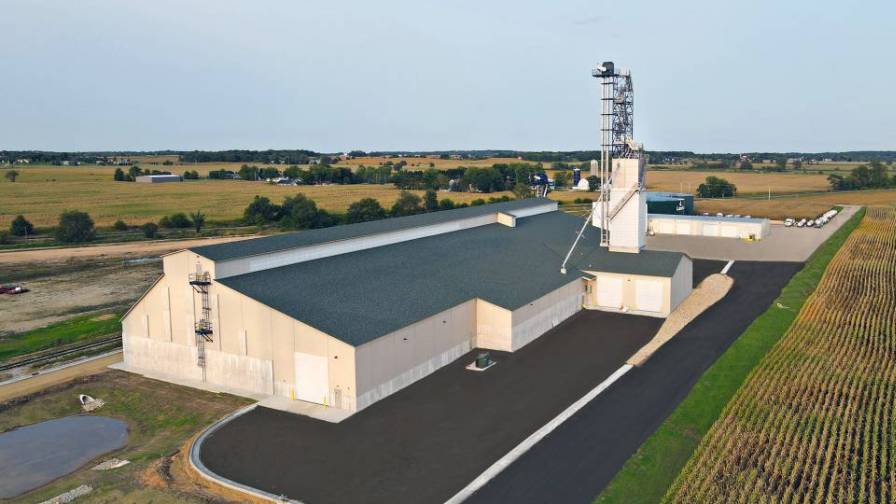The Sustainability Revolution in Phosphate Fertilizer

The Sustainability Revolution in Phosphate Fertilizer
Sustainability: The Cherry on Top
For family farms, the land is more than just an asset; it’s a legacy. There’s a natural drive to be good stewards of this vital resource and that translates to a desire to care for the land and explore more sustainable practices.
Finding ways to balance sustainability with economic viability is crucial in agriculture. This balance becomes especially challenging when farmers face low corn prices and high input costs. Asking them to invest more in sustainable practices can be difficult when they add cost to production. The solution lies in prioritizing economically sound strategies that also offer environmental benefits.
Phospholutions, a sustainable fertilizer technology company, is applying advancements in soil science and nutrient technology to the market and brings a new age phosphorus fertilizer named RhizoSorbⓇ.
Founder and CEO of Phospholutions, Hunter Swisher, says sustainability is the cherry on top.
“Our product is economically viable even without the sustainability benefits. Phosphate manufacturers extend the life of their mines, retailers make better margins over conventional sources, and farmers save money while preserving yield and, in some cases, see an incremental yield gain,” says Swisher. “The sustainability benefits are the cherry on top.”
A Crisis Hiding in Plain Sight
The global food production system heavily depends on fertilizers with phosphate being a critical nutrient that poses a hidden crisis. Unlike nitrogen fertilizers, which can be replenished from the air, phosphate originates from finite reserves that are dwindling.
The Problem with Conventional Phosphate Fertilizers
- Inefficiency: As little as 10% of applied phosphate is taken up by crops in the year of application. Remaining phosphorus bounds to soil particles, becoming unavailable, or is lost to the environment with sediment runoff.
- Over-application: Farmers, relying on banked phosphorus, have been advised to over-apply to ensure crop needs are met. This exacerbates the problem of increases inefficiency and environmental damage and grower’s cost.
- Depletion and Geopolitical Concerns: Phosphate reserves are limited in the U.S., and the United States could be more reliant on imports in the future.
An Antiquated Model Resulting in Over-Application
During the 1960s and 1970s, university extension programs nationwide unified under the belief that phosphorus accumulates like savings in a bank, reassuring farmers that there was no need to be concerned about excessive application.
Steve Levitsky, the Chief Operating Officer, and Vice President of Sustainability at Phospholutions, notes that farmers have traditionally adhered to extension guidance, but our understanding of how phosphate interacts with soil has evolved.
“Farmers were told you have to place nitrogen needed by crop but not to worry about phosphorus because it gets built up in the soil,” says Levitsky. “But in the early 2000’s, a cohort of professors began to research the impact of soluble phosphorus and its loss to the environment due to runoff. Swisher explains that phosphorus is commonly located within the upper 3-6 inches of soil with erosion being the primary mechanism for its environmental loss.
“During significant rain events, soil runs off the farm, removing phosphorus that was bound to the soil particle plus the phosphorus that was in the soil solution and actually available to the plant,” says Swisher.
These are the events that lead to phosphorus finding its way to watersheds and negatively impacting water quality such as algae bloom outbreaks.
Swisher says that phosphorus is needed at 100 times lower quantity than nitrogen to cause an algae outbreak. Algae blooms are commonly attributed to the contribution of carbon emissions.
“When algae breaks down in the water, it releases methane which is a large contributor to greenhouse gases. This is the second largest natural emitter of greenhouse gas emissions worldwide,” says Swisher.
Mine Depletion and Fragile Supply Chains
Phosphates are the second largest nutrient needed for food production, and Swisher is concerned at the rate at which we are depleting resources.
“Our estimates show that we have 30 to 40 years of phosphate reserves left in North America. When we run out, we will be 100% reliant on importing phosphate from countries like Morocco, China, and Russia, which represents a national security challenge” says Swisher.
Sustainability in agriculture means the U.S. has access to the vital nutrients it needs for food production. “U.S. farmers need the most efficient forms of phosphate fertilizers possible. Alternatively, we deplete domestic phosphate mines and find ourselves dependent on importing some of the most important minerals for growing our food. That’s a situation U.S. farmers don’t want to find themselves in,” says Swisher.
For example, Brazil imports about 90% of their phosphates, which puts a lot of strain on the supply chain. When disruptions occur, like covid, additional constraints are put on the supply chain. Farmers are at risk of not achieving the yields they want because of limited access to inputs due to supply chain challenges.
Introducing Phospholutions: A Game-Changer for Sustainable Agriculture
Phospholutions offers a revolutionary solution with their RhizoSorb technology. Here’s how it works:
- Upstream Integration: RhizoSorb is integrated directly into fertilizer production, eliminating the need for additional steps for farmers. It is in the form of a granular fertilizer like MAP/DAP and can be incorporated into the farmer’s existing production practices without additional investment in equipment.
- Controlled Release: Phosphate is pre-loaded onto RhizoSorb, a proprietary material that releases nutrients based on plant needs. The company calls this a plant-driven release, ensuring optimal uptake and minimizing waste. It avoids phosphate being immediately solubilized and getting tied up on soil particles.
- Reduced Application Rates: Studies show that farmers can achieve the same or greater yields with 50% less phosphate applied using RhizoSorb.
Sustainability Benefits of RhizoSorb®
- Reduced Phosphate Use: Lower application rates conserve this finite resource and extend the life of mines and natural resources.
- Improved Water Quality: By minimizing phosphate loss to the environment, RhizoSorb helps protect water quality.
- Lower Carbon Footprint: Reduced phosphate use and a lower-carbon intensity product lead to a significant decrease in greenhouse gas emissions per acre.
Swisher says that many people think sustainability equals carbon emission reductions, but that is not the case.
“There are plenty of sustainability opportunities on the farm. Reducing carbon emissions is one, but it’s not the only one. To have a sustained agriculture industry, we have to carefully manage crop inputs and ensure we have access to vital nutrients,” says Swisher. “That said, using RhizoSorb is about half the carbon footprint per acre compared to MAP, and we are starting to see ways for farmers to get credit for that.”
Phospholutions: A Win-Win for Farmers and the Environment
RhizoSorb is not just an environmentally friendly solution; it also makes economic sense for farmers. By using less fertilizer and preserving or modestly increasing yields, farmers can improve their profitability. Phospholutions’ technology is a prime example of how sustainability and economic benefits can go hand-in-hand.





